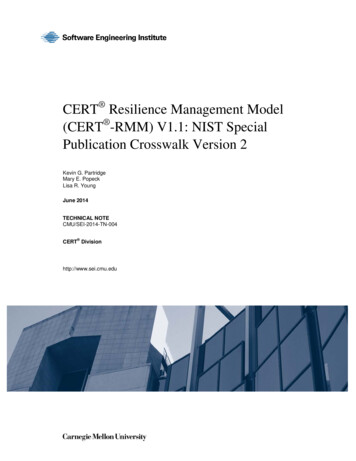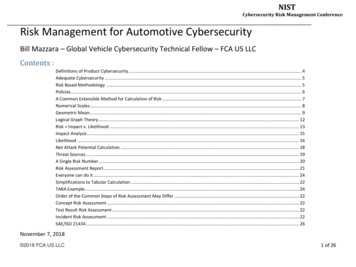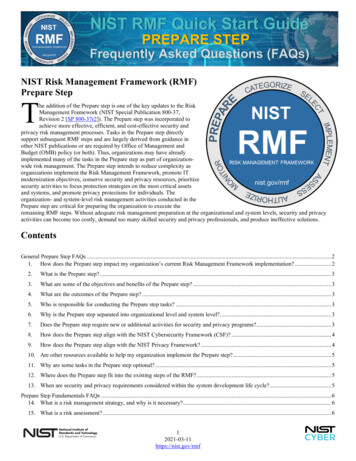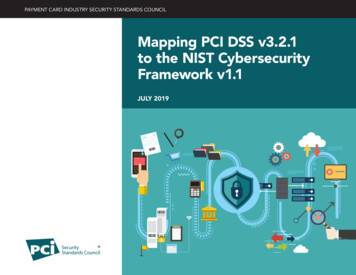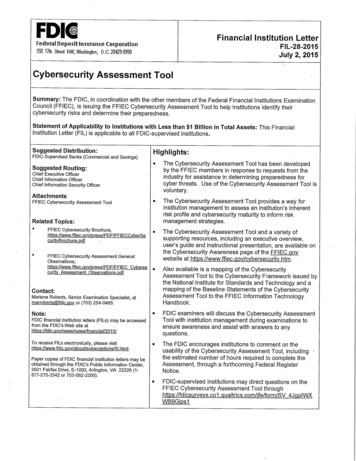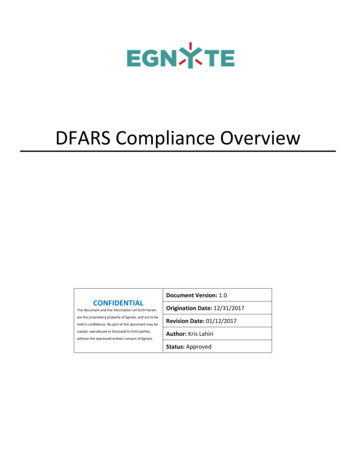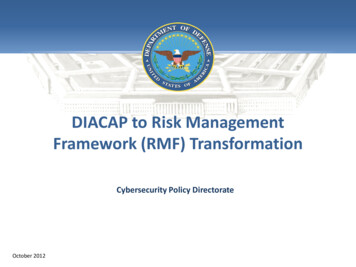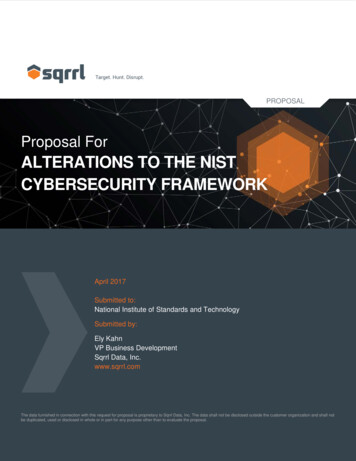
Transcription
PROPOSALProposal ForALTERATIONS TO THE NISTCYBERSECURITY FRAMEWORKApril 2017Submitted to:National Institute of Standards and TechnologySubmitted by:Ely KahnVP Business DevelopmentSqrrl Data, Inc.www.sqrrl.comThe data furnished in connection with this request for proposal is proprietary to Sqrrl Data, Inc. The data shall not be disclosed outside the customer organization and shall notbe duplicated, used or disclosed in whole or in part for any purpose other than to evaluate the proposal.
21CT Proposal Page 2TABLE OF CONTENTS1.0 SQRRL OVERVIEW . 32.0 PROPOSED EDITS TO THE NIST FRAMEWORK . 43.0 INFORMATIVE RESOURCES . 8ABOUT SQRRLSqrrl was founded in 2012 by creators of Apache Accumulo. With their roots in the U.S. Intelligence Community, Sqrrl’s founders have deep experienceworking with and building advanced analytics and Big Data architectures for cybersecurity use cases. Sqrrl is headquartered in Cambridge, MA and is aventure-backed company with investors from Matrix Partners and Atlas Venture.125 Cambridge Park Dr.Suite 401Cambridge, MA 02140p: (617) 902-0784e: info@sqrrl.comwww.sqrrl.com@SqrrlData
1.0 SQRRL OVERVIEWSqrrl Data, Inc. (“Sqrrl”) was born out of the National Security Agency (NSA). With theirroots in the U.S. Intelligence Community, Sqrrl’s founders have worked with some of theworld’s largest, most complex, and most sensitive datasets for the last decade. While atthe NSA, Sqrrl’s founders developed a sorted, distributed key/value store calledAccumulo.Sqrrl is the threat hunting company that enables organizations to target, hunt, anddisrupt advanced cyber threats. Sqrrl’s industry-leading Threat Hunting Platform uniteslink analysis, User and Entity Behavior Analytics (UEBA), and multi-petabyte scalabilitycapabilities into an integrated solution. Sqrrl reduces attacker dwell time by detectingadversarial behavior faster and with fewer resources through the use of machinelearning, and enables effective threat hunting. As an incident response tool, it enablesanalysts to investigate the scope, impact, and root cause of an incident more efficientlyand thoroughly than ever before.Sqrrl is headquartered in Cambridge, MA. Users of Sqrrl Enterprise include Fortune100 companies in finance, telecom, healthcare, and large government agencies.
2.0 PROPOSED EDITS TO THE NIST FRAMEWORKI.Proposed Edits to NIST Cybersecurity FrameworkInsert under DE.DP-2: “Detection processes incorporate both detection of threats byautomated systems and by human-driven threat hunting”II.Justification for EditsA. Summary: Currently, the section on detection methods focuses principallyon automated detection. However, in modern SOCs, detection processesinvolve both an automated and a human-driven component. This latterapproach is referred to as “threat hunting,” which is defined as proactivelyand iteratively searching for threats that have evaded detection byautomated detection systems. 1There are three key reasons for why threat hunting should be explicitlyincluded in the definition of detection processes:First, threat hunting is distinct from automated detection. Automateddetection mechanisms, such as firewalls, IDS/IPS, SIEMs, and neweradvanced analytic tools continuously run in the background firing off alertsusing heuristics, matching algorithms, and statistical models. Threathunting, on the other hand, is a human-driven process that is designed tolook for the threats that automated systems miss. 2 Hunters arecontinuously innovating and adapting to new attacker techniques, andoften detecting attacks that sit in the gaps of automated systems.The second reason for this explicit inclusion is that threat hunting is one ofthe fastest-growing trends in cyber security and is rapidly becoming asecurity staple for SOCs. In a recent industry study, 86% of securityprofessionals stated that their firms engaged in some form of threathunting. 3 This number is likely to continue to rise as the industrystandardizes detection methodologies which best incorporate automatedand human-driven detection. Additionally, a 2017 Information SecurityCommunity study found that 79% of information security staff feel thatthreat hunting should or will be their top priority in the upcoming year. 4Finally, Gartner (a top IT research and advisory firm) is currentlydeveloping research to solidify threat hunting as one of the key functionsof a SOC. 51Lee, Robert M., Lee, Rob, “The Who, What, Where, When, Why and How of Effective Threat Hunting, SANS Institute InfosecReading RoomIbid.3Cole, Eric, “Threat Hunting: Open Season on the Adversary,” SANS Institute InfoSec Reading Room, 20164Jai, Vijayan, “Threat Hunting Becoming Top of Mind Issue for SOCs,” Darkreading, 2017, accessed 4/7/20175Chuvakin, Anton, “Planned: A Quick Paper on Threat Hunting – Ideas Sought,” Gartner Blog Network, 2017, accessed 4/6/20172
Finally, threat hunting is critical to improving the efficiency and operationaleffectiveness of modern SOCs. The value from manual hunts derives fromthe fact that automated detection systems cannot catch 100 percent ofattacks. Instead of just being focused on one or two steps of the attack killchain (see: fig. 1.1) hunters are able to identify intruders at any stage of anattack. Threat hunting allows analysts to mitigate the effect of breaches byidentifying them before adversaries are able to act upon their objectives.In a survey of 494 organizations conducted by the SANS Institute, 52% ofrespondents said that hunting techniques had found previously undetectedthreats on their enterprise. Additionally, 74% of respondents stated thatthreat hunting reduced their attack surfaces and 59% stated that threathunting improved the speed and accuracy of their responses to threats. 6Fig. 1.1: the Cyber Threat Kill ChainB. Threat Hunting Background InformationHistory and Definitions of HuntingThe term “threat hunting” originated with the US Air Force in the mid2000’s, when they began to use teams of security analysts to conduct“friendly force projection on their networks. 7 As it was adopted by theprivate sector, analysts began referring to these practices simply as“hunting,” leading to the term “threat hunting” being widely adopted by theearly 2010’s. Human-driven detection entails security analysts searchingthrough their network in order to find suspicious behavior. 8 Although theindustry standard for threat hunting is still being finalized, the vast majorityof hunts can be grouped according to the Threat Hunting Loop (fig. 1.2).This is an iterative process wherein hunters identify areas deemed to beespecially vulnerable, investigate said areas, and then incorporateintelligence and information gained into future hunts. 96Cole, Eric, “Threat Hunting: Open Season on the Adversary,” 2016Bejtlich, Richard, “Become a Hunter: Fend off Modern Computer Attacks by Turning your Incident Response Team into CounterThreat Operations,” Information Security, 20118Sqrrl, “A Framework for Cyber Threat Hunting,” Sqrrl Enterprise, 2016, accessed 4/1/20169Sqrrl, “The Threat Hunting Reference Model Part 2: The Hunt Loop, Sqrrl Blog, 2016, accessed 3/27/20177
Fig. 1.2: the Threat Hunting LoopAnalysts improve the success of their hunts by incorporatingintelligence and information about wider industry trends, malwaredevelopments, and adversary tactics, techniques, and procedures(TTPs). Hunters also employ “security information and eventmanagement” (SIEM) tools that use machine learning to track longterm trends on the host network and provide data that can be used toformulate future hunts. 10 Using these tools, data gained from manuallyconducted hunts drives and informs automated systems. The relativeefficiency of SOCs can be assessed via the hunting maturity model(fig. 1.3). Using this metric we can observe that SOCs with exceptionaldetection procedures have high levels of data collection about theirnetwork, and use that to define hunt targets.10Long, Michael C., “Scalable Methods for Conducting Cyber Threat Hunt Operations” SANS Institute InfoSec Reading Room, 2016
Fig 1.3: The Hunt Maturity ModelII.Submitted BackgroundC. Ely Kahn is a co-founder and VP of Business Development for Sqrrl.Previously, Ely served in a variety of positions in the Federal Government,including Director of Cybersecurity at the National Security Staff in WhiteHouse, Deputy Chief of Staff at the National Protection ProgramsDirectorate in the Department of Homeland Security, and Director of RiskManagement and Strategic Innovation in the Transportation SecurityAdministration. Before his service in the Federal Government, Ely was amanagement consultant with Booz Allen Hamilton. Ely has a BA fromHarvard University and a MBA from the Wharton School at the Universityof Pennsylvania.
3.0 INFORMATIVE RESOURCESCrowd Research Partners, “Threat Hunting: 2017 Report,” Crowd Research Cole, Eric, “Threat Hunting: Open Season on the Adversary,” SANS Institute InfoSecReading Room, 2016 erprise Strategy Group, ESG Research Report: Network Security Trends in the Eraof Cloud and Mobile Computing, ESG Publishing, 2014 ( securitytrendsincloudmobile/Marketing )Sqrrl, “A Framework for Cyber Threat Hunting,” Sqrrl Enterpirse, Hunting-Whitepaper.pdf)
Sqrrl is the threat hunting company that enables organizations to target, hunt, and disrupt advanced cyber threats. Sqrrl's industry-leading Threat Hunting Platform unites link analysis, User and Entity Behavior Analytics (UEBA), and multi-petabyte scalability capabilities into an integrated solution. Sqrrl reduces attacker dwell time by .


